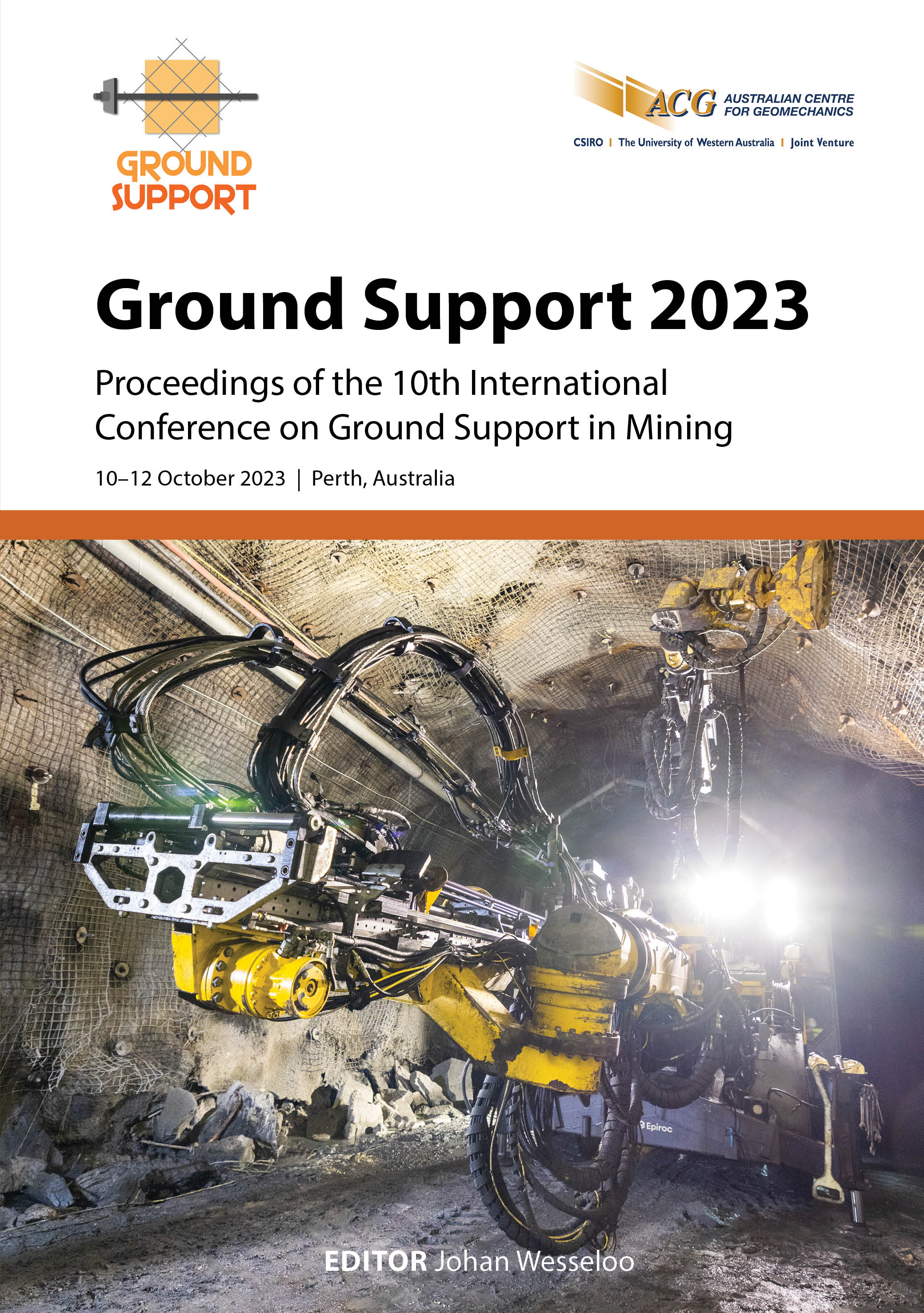Dynamic modelling of strainbursting around tunnels

|
Authors: Rigby, A |
DOI https://doi.org/10.36487/ACG_repo/2325_10
Cite As:
Rigby, A 2023, 'Dynamic modelling of strainbursting around tunnels', in J Wesseloo (ed.), Ground Support 2023: Proceedings of the 10th International Conference on Ground Support in Mining, Australian Centre for Geomechanics, Perth, pp. 151-164, https://doi.org/10.36487/ACG_repo/2325_10
Abstract:
Crush-type seismic sources locating to tunnels are abundant at many mines, particularly those where stress is high and the rock is competent. These events are associated with the dynamic stress fracturing of rock around a tunnel and the convergence of the surrounding elastic rock mass into the tunnel’s void. When associated with observable damage to the excavation, such events are termed strainbursts. Given that strainbursts can pose significant risk both in terms of safety and impact on production, understanding the demand they place on the ground support system is a problem of practical interest. The demand placed on support by a given strainburst depends on how failure in the rock develops dynamically in space and time. While some information about this failure can be inferred from seismic data, it cannot provide a full description on its own. To gain further insight, we have conducted dynamic threedimensional modelling of strainbursting around a tunnel for various cases of loading conditions and rock mass properties. The results of these cases are analysed to quantify aspects of the source dynamics. In particular, we estimate the velocities and durations of failure propagation axially along the tunnel and radially outwards from the tunnel's surface. It is shown that these velocities, particularly in the case of radial propagation, are significantly lower than that expected for confined shear failure. We have also determined moment tensors, which give information about static/permanent deformation at the source. For each of the modelled cases, the moment tensor was of crush-type with a P-axis approximately aligned with maximum in-plane loading of the tunnel.
Keywords: strainbursting, numerical modelling, seismic sources
References:
Brune, JN 1970, ‘Tectonic Stress and the Spectra of Seismic Shear Waves from Earthquakes’, Journal of Geophysical Research, vol. 75, no. 26, pp. 4997–5009.
Chounet, A, Vallée, M, Causse, M & Courboulex, F 2018, ‘Global catalog of earthquake rupture velocities shows anticorrelation between stress drop and rupture velocity’, Tectonophysics, vol. 733, pp. 148–158.
Diederichs, MS 2007, ‘The 2003 Canadian Geotechnical Colloquium: Mechanistic interpretation and practical application of damage and spalling prediction criteria for deep tunnelling’, Canadian Geotechnical Journal, vol. 44, no.9, pp. 1082–1116.
Gao, F, Kaiser, PK, Stead, D, Eberhardt, E & Elmo, D 2019, ‘Numerical simulation of strainbursts using a novel initiation method’, Computers and Geotechnics, vol. 106, pp. 117–127.
Hajiabdolmajid, V, Kaiser, PK & Martin, CD 2002, ‘Modelling brittle failure of rock’, International Journal of Rock Mechanics and Mining Sciences, vol. 39, no. 6, pp. 731–741.
Hang, S 2015, ‘TetGen, a Delaunay-Based quality tetrahedral mesh generator’, ACM Transactions on Mathematical Software, vol. 41, no. 2, pp. 11.
Hanks, TC & Kanamori, H 1979, ‘A moment magnitude scale’, Journal of Geophysical Research: Solid Earth, vol. 84, no. B5,
pp. 2348–2350.
Itasca Consulting Group 2009, ‘Theory and background’, FLAC3D: Fast Lagrangian Analysis of Continua in 3 Dimensions, 4th edn, Itasca Consulting Group, Minneapolis.
Kaiser, PK & Malovichko, DA 2022, ‘Energy and displacement demands imposed on rock support by strainburst damage mechanisms’, Proceedings of the Tenth International Symposium on Rockbursts and Seismicity in Mines, Society for Mining, Metallurgy
& Exploration, Englewood.
Malovichko, DA 2020, ‘Description of seismic sources in underground mines: theory’, Bulletin of the Seismological Society of America, vol. 110.
Malovichko, DA 2022, ‘Utility of seismic source mechanisms in mining’, Proceedings of the Tenth International Symposium on Rockbursts and Seismicity in Mines, Society for Mining, Metallurgy & Exploration, Englewood.
Malovichko, DA & Rigby, A 2022, ‘Description of seismic sources in underground mines: dynamic stress fracturing around tunnels and strainbursting’, arXiv,
Manouchehrian, A & Cai, M 2018, ‘Numerical modeling of rockburst near fault zones in deep tunnels’, Tunnelling and Underground Space Technology, vol. 80, pp. 164–180.
Ryder, JA 1988, ‘Excess shear stress in the assessment of geologically hazardous situations’, Journal of the Southern African Institute of Mining and Metallurgy, vol. 88, no. 1, pp. 27–39.
Sørensen, ES, Clausen, J & Damkilde, L 2015, ‘Finite element implementation of the Hoek-Brown material model with general strain softening behavior’, International Journal of Rock Mechanics and Mining Sciences, vol. 78, pp. 163–174.
Wang, B, Vardon, PJ, Hicks, MA & Chen, Z 2016, ‘Development of an implicit material point method for geotechnical applications’, Computers and Geotechnics, vol. 71, pp. 159–167.
© Copyright 2025, Australian Centre for Geomechanics (ACG), The University of Western Australia. All rights reserved.
View copyright/legal information
Please direct any queries or error reports to repository-acg@uwa.edu.au
View copyright/legal information
Please direct any queries or error reports to repository-acg@uwa.edu.au
